Physical Address
304 North Cardinal St.
Dorchester Center, MA 02124
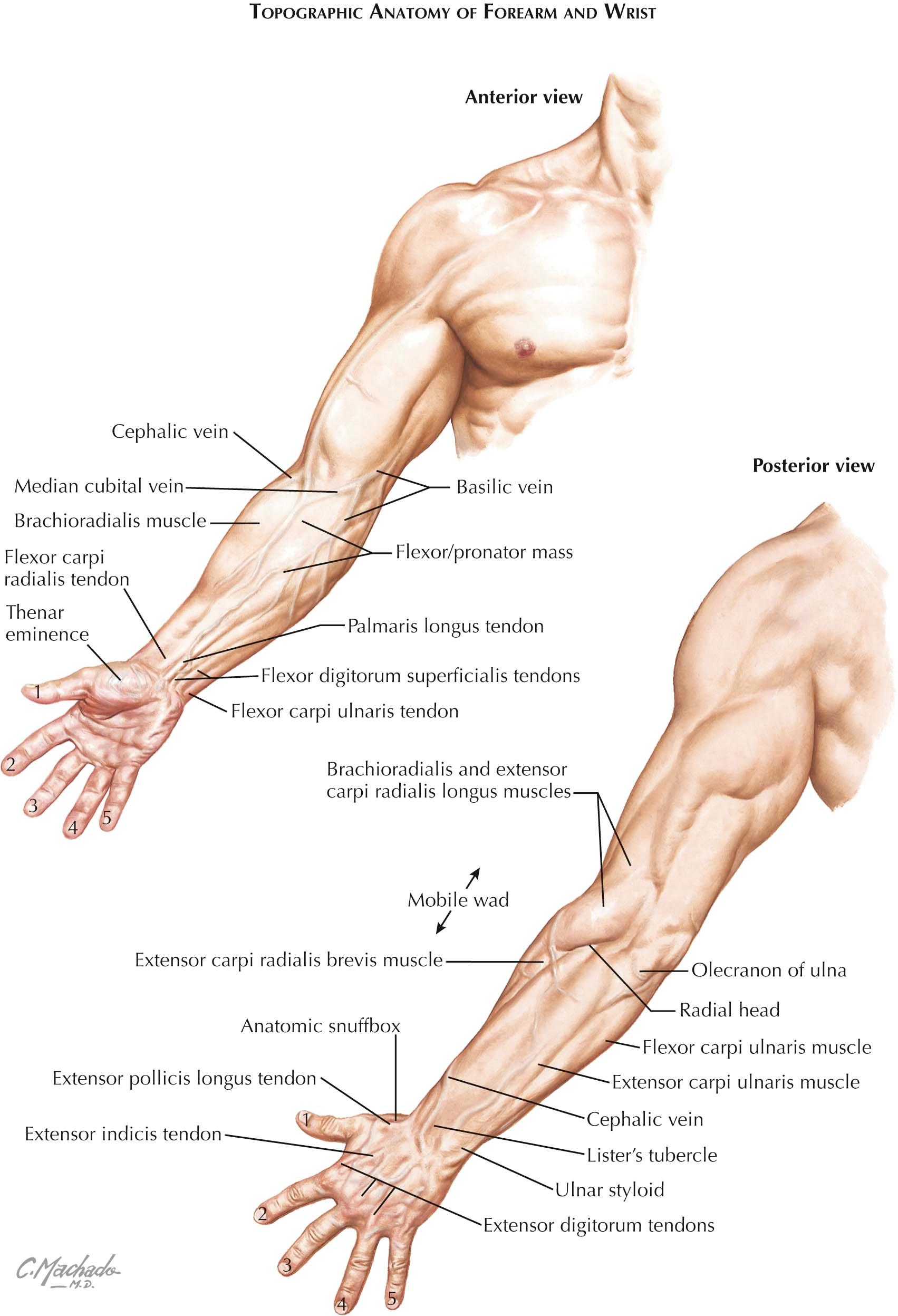
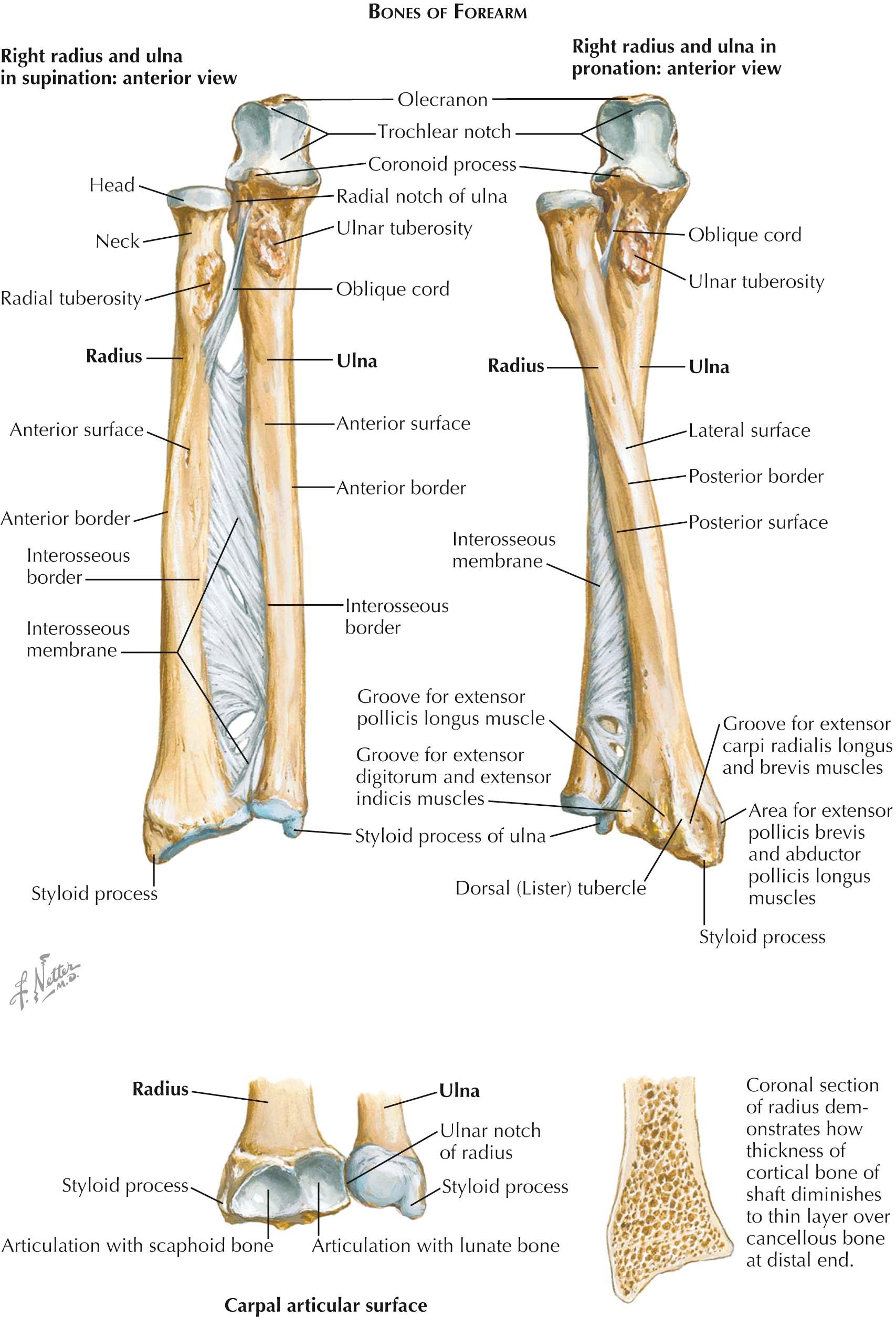
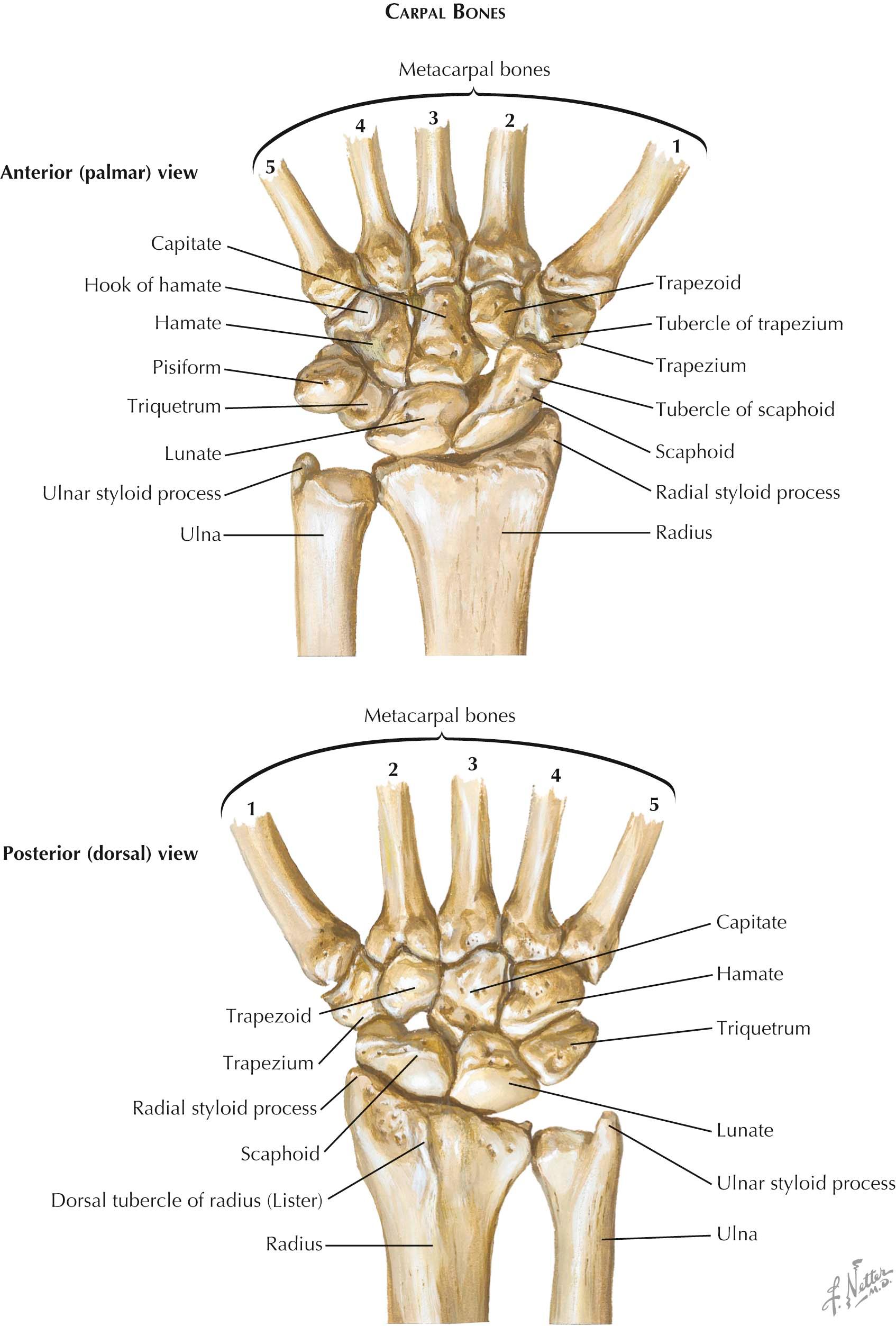
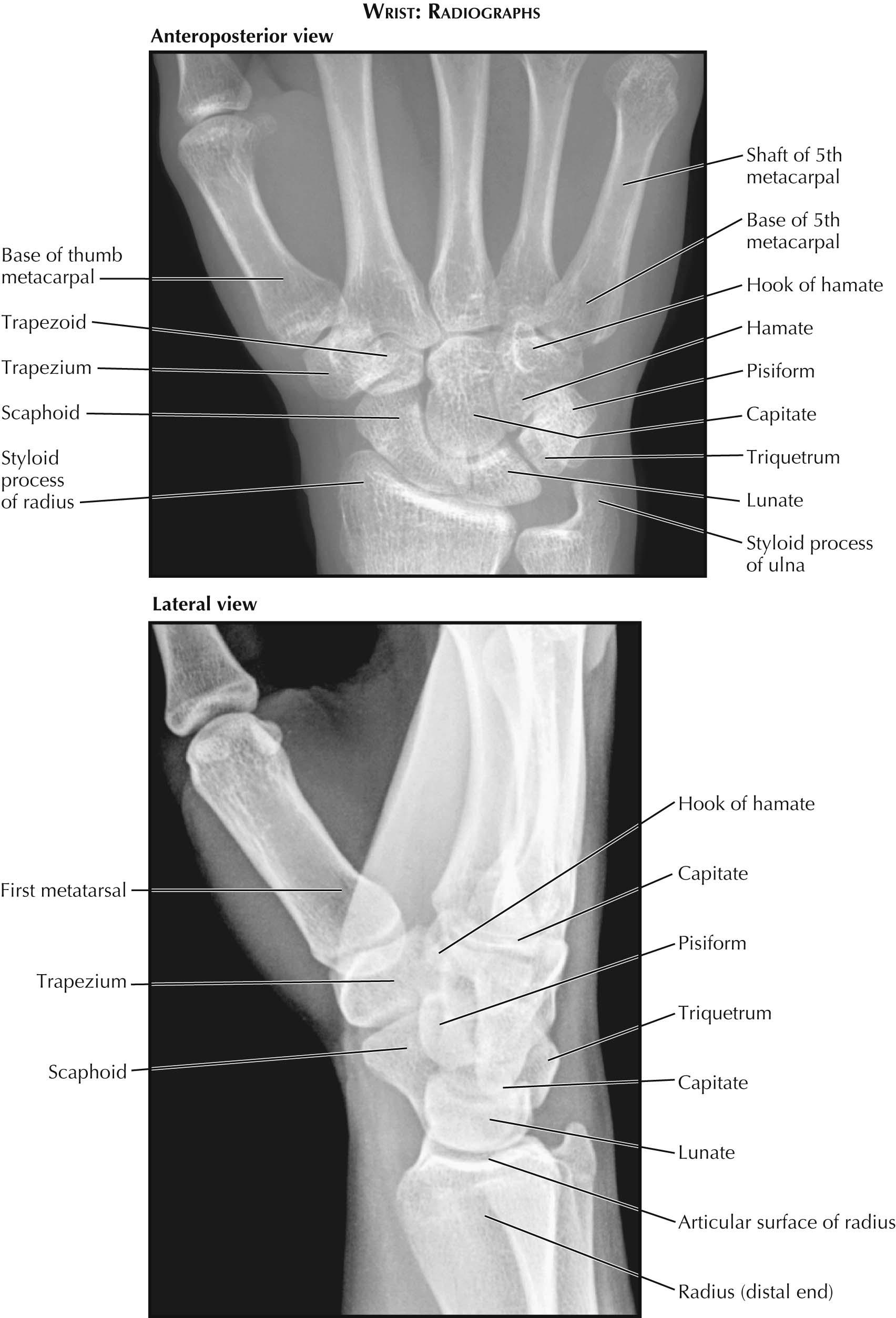
The distal end of the radius is broadened because its carpal articular surface is the bony contact of the forearm with the wrist and hand. This surface is concave transversely and anteroposteriorly; it is divided by a surface constriction and a slight ridging into a larger triangular portion laterally and a smaller quadrangular part medially, which are for the reception of the scaphoid and the lunate of the wrist, respectively.
The medial surface of the distal extremity of the radius is also concave and articular. As the ulnar notch of the radius, it receives the rounded head of the ulna. Dorsally, the distal part of the radius exhibits its tubercle and is otherwise somewhat ridged and grooved for the passage of the tendons of the forearm extensor muscles. Laterally, the bone ends in a downwardly projecting styloid process.
The distal radius and ulna have a rich vascular supply coming from the radial, ulnar, anterior interosseous, and posterior interosseous arteries. The vessels that supply the dorsum of the distal radius can be described for the corresponding extensor tendon compartments as either intercompartmental or compartmental. Nutrient vessels branch off the main vessels and penetrate the retinaculum and underlying bone. An example is the 1,2 intercompartmental supraretinacular artery. A branch off the radial artery, it gives nutrient branches to the bone between the first and second extensor tendon compartments. Clinically, the vessel and its corresponding branches and underlying bone can be harvested and utilized for vascularized bone grafting procedures in the carpus (for example, for a scaphoid nonunion with avascular proximal pole).
Ossification begins in the distal extremity of the radius at the end of the first year, and fusion takes place at age 19 to 20.
The ulna has a small distal extremity. There is a small, rounded styloid process in line with the posterior border of the bone, and there is also a larger, rounded head. The distal surface of the head is smooth for contact with the articular disc of the distal radioulnar joint; it is continuous with the distal surface of the circumference of the head, which is received into the ulnar notch of the head of the radius.
An ossification center for the distal end of the ulna appears at age 5 or 6 and fuses with the shaft at age 18 to 20.
The skeleton of the wrist consists of eight small bones arranged in two rows, proximal and distal. The bones of the proximal row, from the radial to the ulnar side, are the scaphoid, the lunate, the triquetrum, and the pisiform. Those of the distal row, in the same order, are the trapezium, the trapezoid, the capitate, and the hamate. Fundamentally, these bones may be thought of as cubes, each of which has six surfaces. Their dorsal and palmar surfaces are nonarticular and provide for the attachment of the dorsal and palmar ligaments that hold them closely together.
The other surfaces are articular, except for the subcutaneous surfaces of the bones that form the borders of the wrist. These surfaces also mostly lodge ligaments. The proximal articular surfaces are generally convex; the distal surfaces are usually concave. Foramina for the entrance of blood vessels are found on nonarticular areas of each bone.
The boat-shaped scaphoid is the largest bone of the proximal row. Its smooth radial articular surface is convex and triangular. The smooth distal surface is triangular but concave and receives both the trapezium and the trapezoid. The medial surface presents two articular facets—one for the lunate and a larger inferior concavity for part of the head of the capitate.
The lunate is crescentic; its proximal convexity is for the more medial of the articular surfaces of the distal end of the radius. The distal surface is deeply concave for the capitate and for a small contact with the hamate. On its radial surface, this bone contacts the scaphoid; medially, it has a surface for the base of the triquetrum.
The triquetrum is pyramidal, with the base of the pyramid toward the lunate and the apex downward and ulnarward on the ulnar border of the wrist. The inferior surface is sinuously curved for articulation with the hamate, and the palmar surface has an oval facet for the pisiform.
The pisiform is small and has been likened to a pea. Its single articular facet is for the triquetrum. The pisiform may be regarded as a sesamoid formed in the tendon of the flexor carpi ulnaris muscle.
The trapezium is the radialmost bone of the distal row of carpals. Its proximomedial surface is concave for articulation with the scaphoid, and its distal surface has a saddle-shaped facet for the base of the first metacarpal. On the palmar surface of the bone is a tubercle and a deep groove, through which passes the tendon of the flexor carpi radialis muscle. The tubercle gives attachment to the superficial lamina of the flexor retinaculum and to several thumb muscles. The medial surface of the trapezium has a large concave facet proximally for articulation with the trapezoid and has a small, flat oval surface at the distal angle of the bone for the second metacarpal.
The trapezoid is somewhat wedge shaped, with the broader base of the wedge dorsally. The quadrilateral proximal surface articulates with the scaphoid, whereas distally there is a large saddle-shaped articular surface for the base of the second metacarpal. The lateral surface is convex for the trapezium, whereas the medial surface has a smooth facet for the capitate.
The capitate is the largest of the carpal bones and occupies the center of the wrist. Its rounded head is received into the concavity of the scaphoid and the lunate. The distal, somewhat cuboidal extremity articulates chiefly with the base of the third metacarpal, but by means of small lateral and medial facets it also makes contact with the bases of the second and third metacarpals. The lateral surface has, distally, a small, smooth facet for the distal extremity of the trapezoid, and the medial surface has an oblong articular surface for the hamate.
The hamate is wedge shaped and has a characteristic hooklike process, the hamulus, or hook. The apical proximal part of the wedge articulates with the lunate; the broad distal surface has two concave facets for the bases of the fourth and fifth metacarpals. Articular surfaces laterally and medially are for the capitate and triquetrum, respectively. The hamulus gives attachment to the flexor retinaculum and the tendon of the flexor carpi ulnaris muscle and provides origin for several small finger muscles.
Ossification takes place from a single center in each bone. It begins first in the capitate and then in the hamate early in the 1st year; in the triquetrum, during the 3rd year; in the lunate, in the 4th year; in the trapezium, trapezoid, and scaphoid, in rather close sequence, in the 4th to 6th years; and in the pisiform, in the 11th or 12th year. Ossification starts earlier in the female and is completed between ages 14 and 16. The hamulus of the hamate may have a separate center. An os centrale, normally part of the scaphoid, may be present between the scaphoid, capitate, and trapezoid.
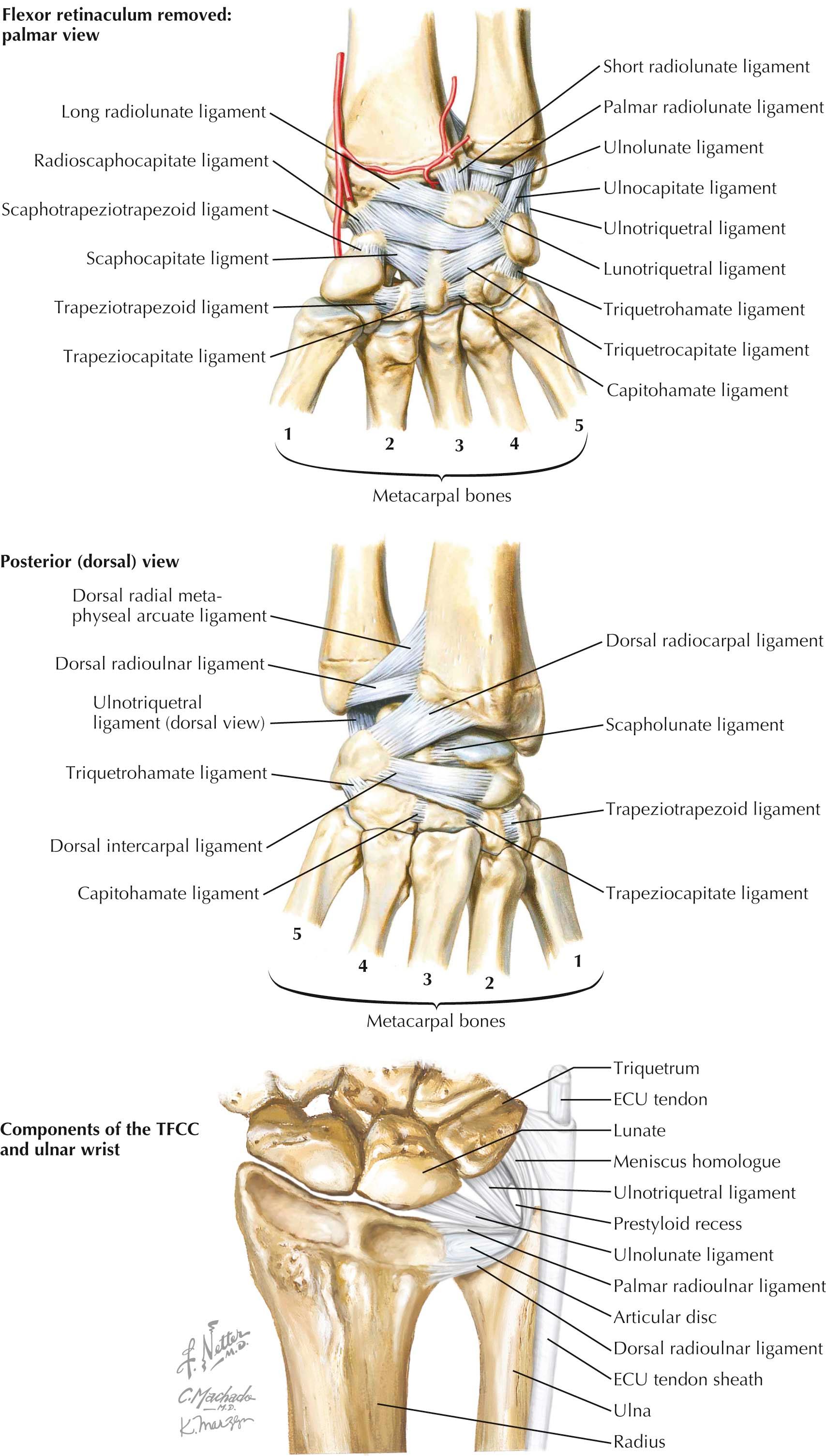
The ligaments of the wrist are divided into three separate groups: the dorsal intercapsular, the volar radiocarpal, and the interrosseous ligaments. Confusion regarding these structures often centers on the numerous different names utilized to identify these structures. The volar radiocarpal ligaments are the most critical of these structures and provide the majority of ligamentous stability to the carpus. The volar ligaments consist of the radioscaphocapitate ligament, the long/short radiolunate ligaments, the radioscapholunate ligaments (more of a vascular conduit), and the ulnotriquetral and ulnolunate ligaments. The radioscaphocapitate ligament is a critical restraint to ulnar translocation of the carpus and must be preserved during proximal row carpectomy and/or during radial styloidectomy. The space of Poirier is a weak point between the radioscaphocapitate and long radiolunate ligaments, where the lunate can dislocate during a lunate dislocation. During a volar approach to lunate/perilunate dislocations this space can be sutured to provide increased stability to the injured carpus. The dorsal intercapsular ligaments consist of the dorsal radiocarpal and dorsal intercarpal ligaments. These provide additional structural support to the carpus, and numerous “ligament-sparing approaches” to the wrist have been described to preserve these structures. These dorsal ligaments can also be utilized to correct carpal instability by being transferred to function as a capsulodesis. There are numerous intercarpal ligaments, the most critical being the scapholunate and lunotriquetral ligaments. Disruption of these intercarpal ligaments can lead to dorsiflexed or volar-flexed intercalated segment instability (DISI or VISI) deformities, respectively. Repair of these ligaments can be performed in the acute setting, whereas numerous reconstructive procedures have been described for use in the chronic setting when symptomatic.
The triangular fibrocartilage complex (TFCC) describes a confluence of soft tissue structures that stabilize the distal radioulnar joint (DRUJ) and transmit forces across the ulnocarpal joint. The individual components include dorsal and palmar radioulnar ligaments, meniscus homologue, ulnotriquetral and ulnolunate ligaments, articular disc, and the extensor carpi ulnaris subsheath. The dorsal and palmar radioulnar ligaments are most critical for DRUJ stability. TFCC pathology can often be diagnosed and treated with arthroscopic techniques.
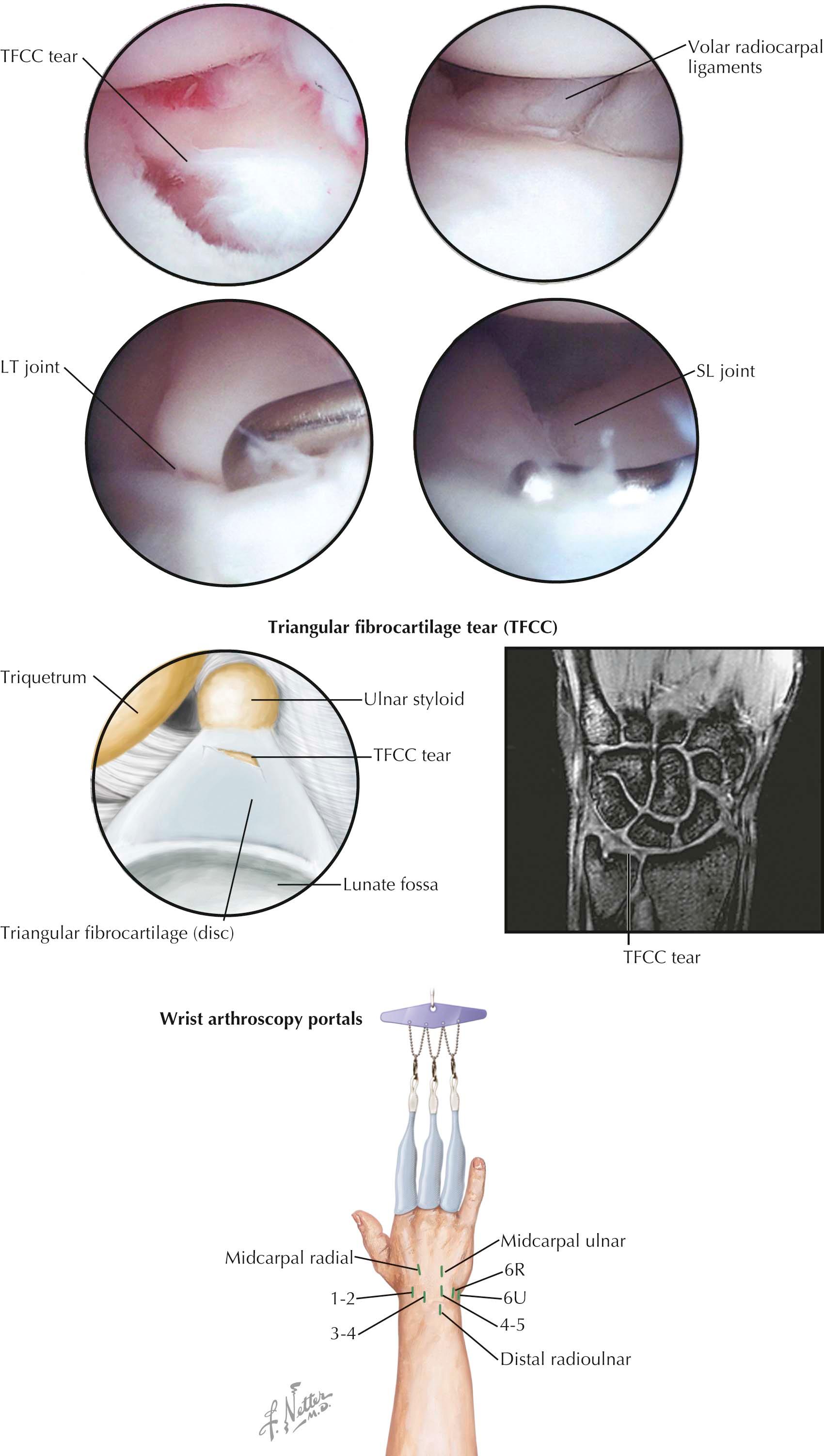
Wrist arthroscopy has been rapidly evolving over the past 25 years from an experimental diagnostic instrument to a powerful tool for both accurate diagnosis and treatment of numerous ailments. Advances in camera technology, small instrument design, safe portal identification, and, most importantly, surgeon experience and comfort have all played a role in the development of this treatment modality.
Currently, wrist arthroscopy is considered the gold standard for evaluating and often treating chronic wrist pain. TFCC injuries are a common cause of chronic ulnar-sided wrist pain. Wrist arthroscopy allows accurate identification of these injuries, determination of central versus peripheral injury, and treatment. Central TFCC tears cause painful clicking and catching in the wrist and can be debrided arthroscopically back to a stable rim of tissue. Peripheral detachment of the TFCC from the distal ulna causes ulnar-sided wrist pain with potential instability of the DRUJ and can be successfully treated with the arthroscopic passage of sutures and secure repair with gratifying results. Radiocarpal and midcarpal synovectomy, ganglion excision, scapholunate and lunotriquetral tear debridement versus repair, and loose body removal can also all be successfully treated arthroscopically. Arthroscopic visualization of both distal radius and scaphoid fracture fixation has also been reported as an adjunct to standard treatment, allowing direct visualization of intra-articular reduction and fixation.
Wrist arthroscopy requires a thorough understanding of wrist anatomy to allow safe passage of instrumentation and recognition of the anatomy and pathologic processes encountered. Arthroscopic portals are identified by their relationship to the numbered extensor tendon compartments along the dorsum of the wrist. The standard viewing portal is the 3-4 portal, with supplemental portals for instrumentation often occurring at the 4-5 interval or on either side of the extensor carpi ulnaris tendon (6R and 6U). Midcarpal arthroscopy is a critical component to any diagnostic wrist arthroscopy. The midcarpal viewing and working portals allow accurate evaluation and grading of both scapholunate and lunotriquetral instability. More advanced arthroscopists have utilized both palmar portals and DRUJ portals for enhanced viewing of complex intra-articular ailments.
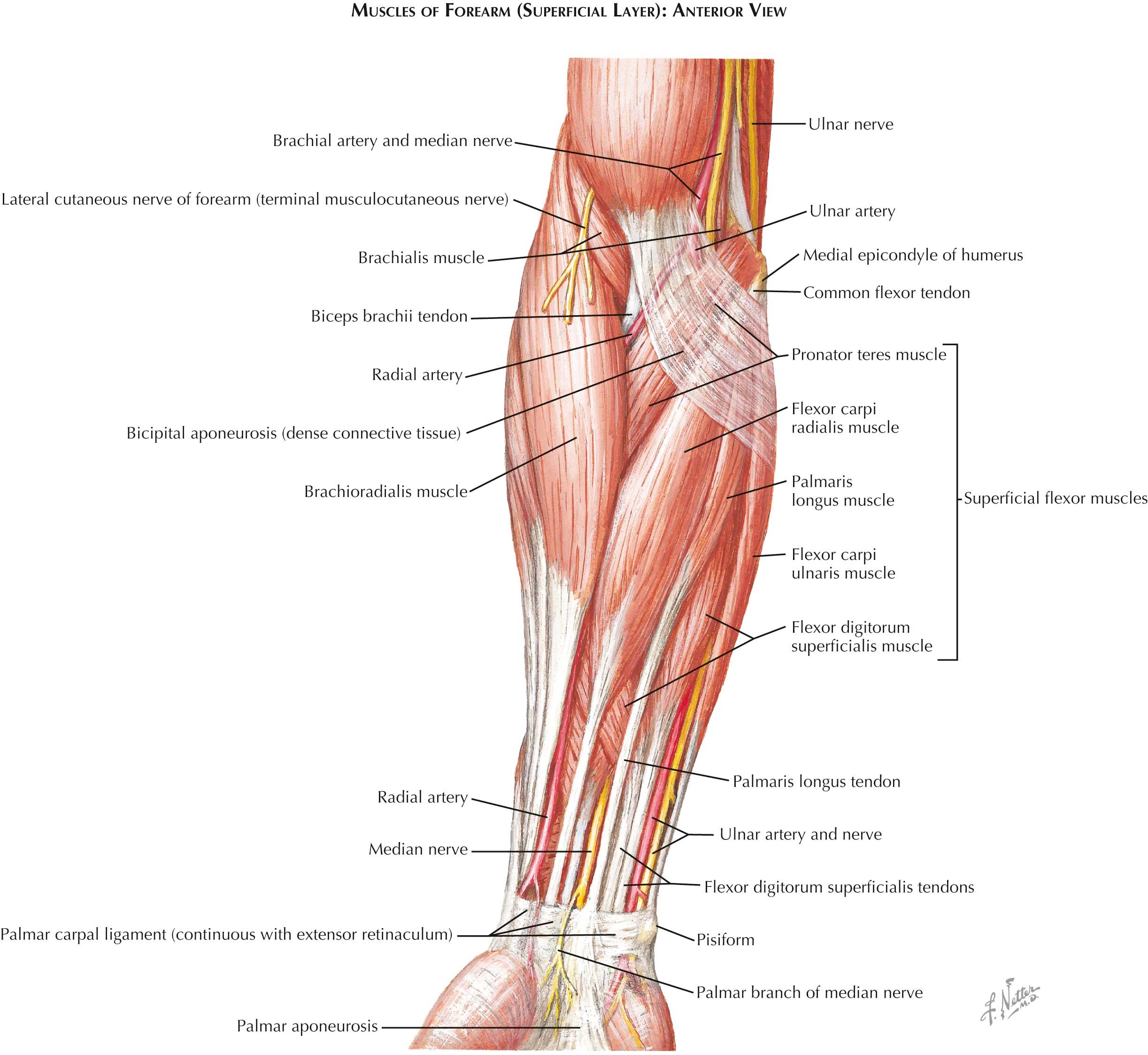
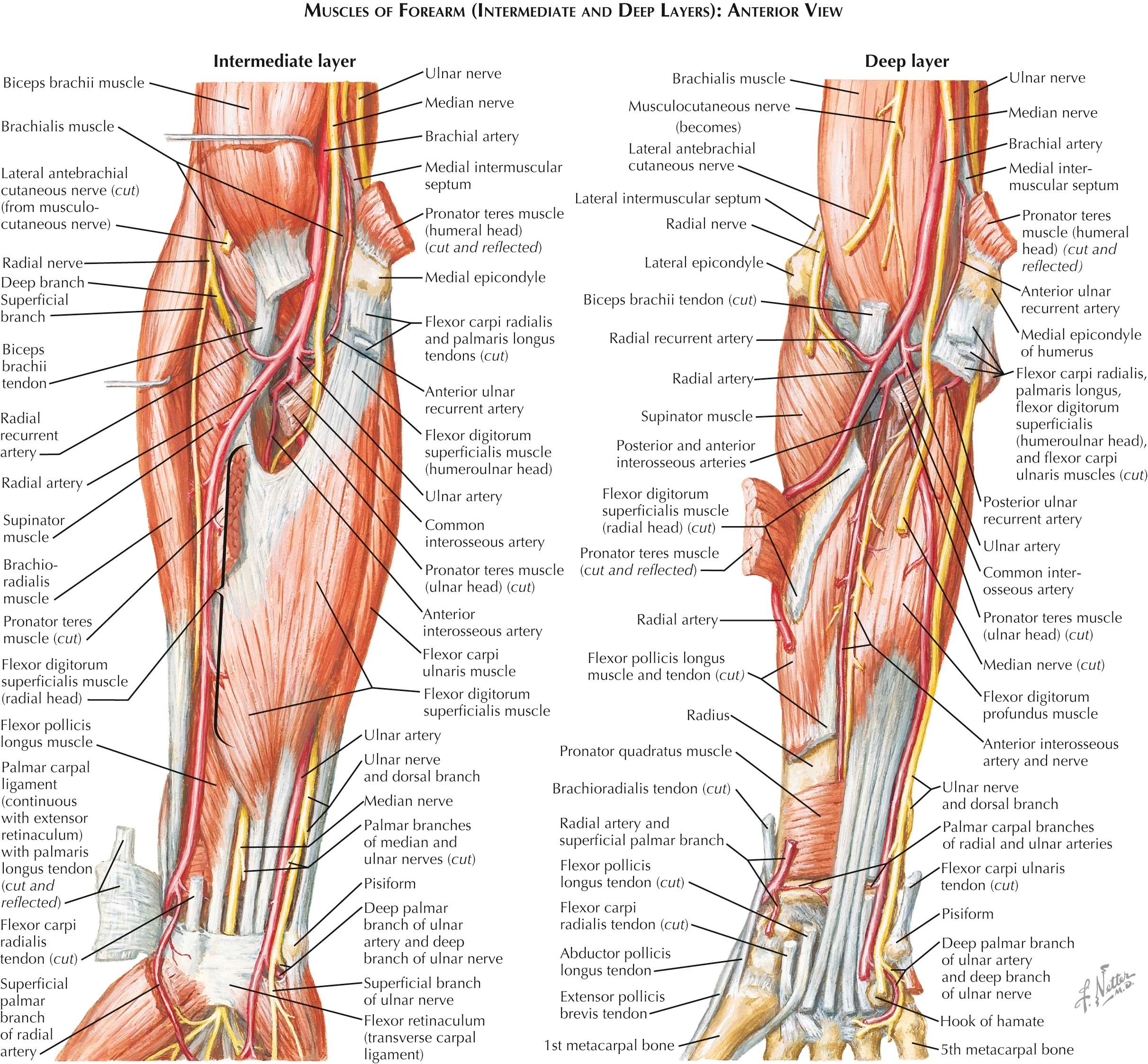
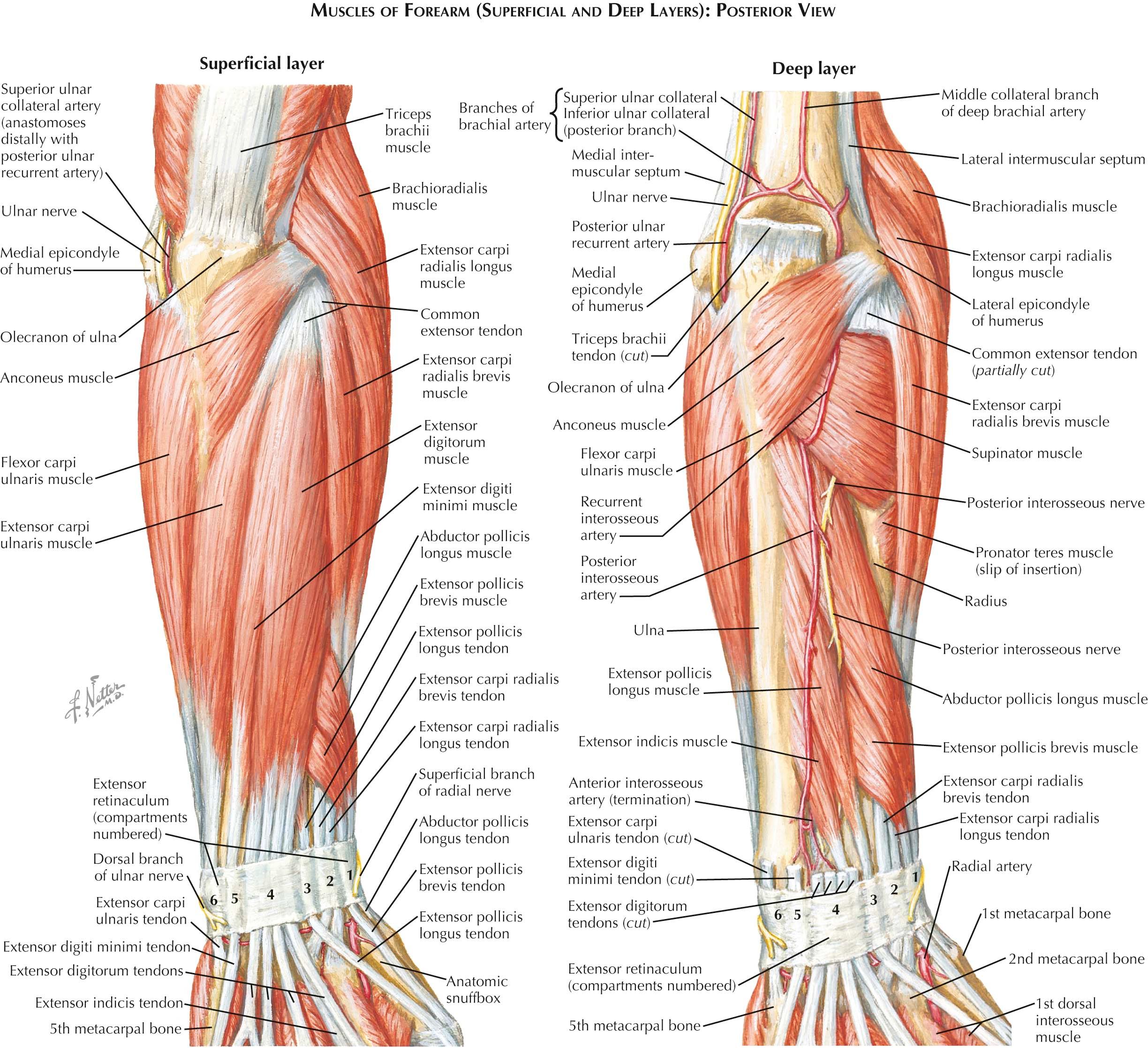
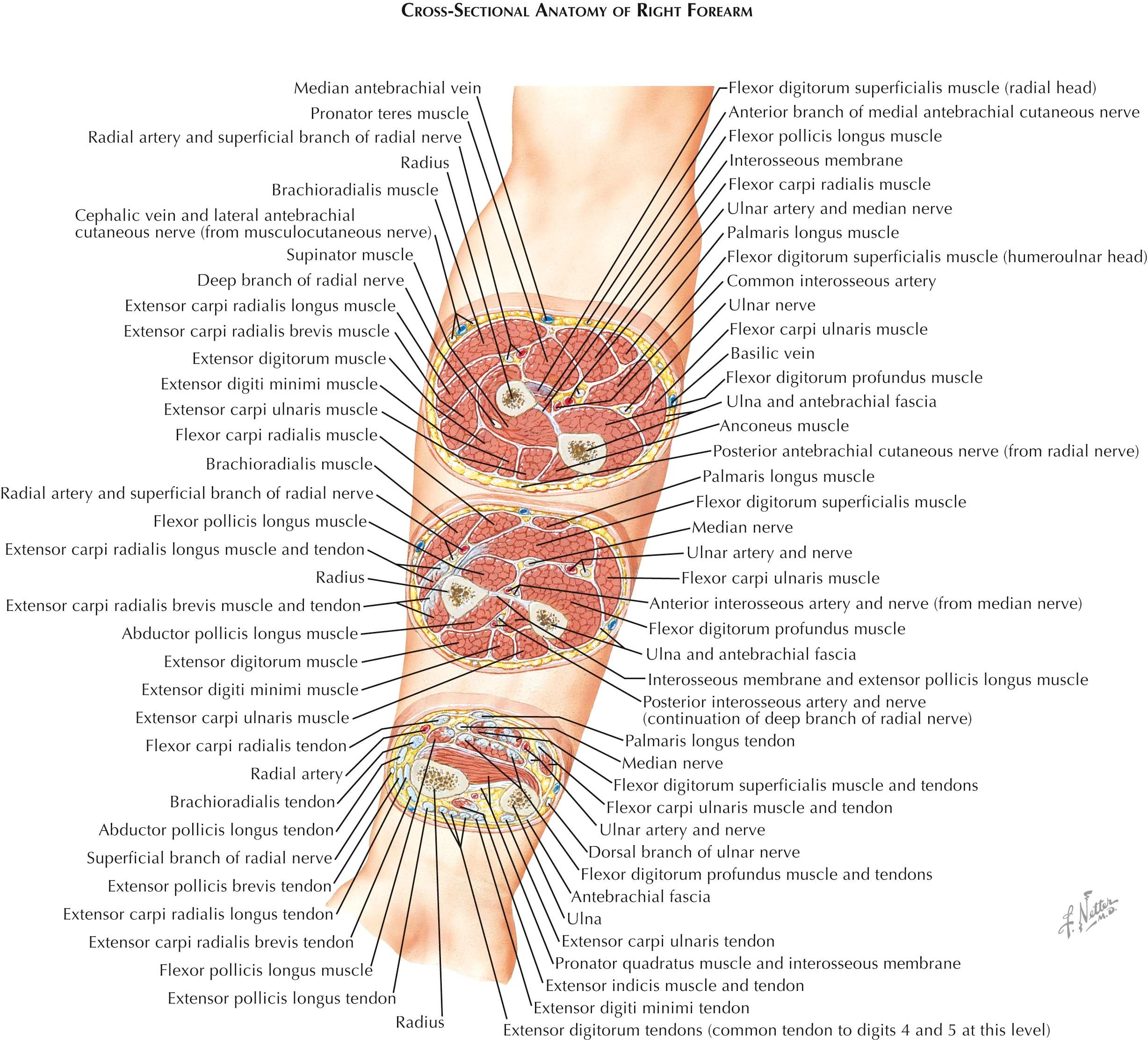
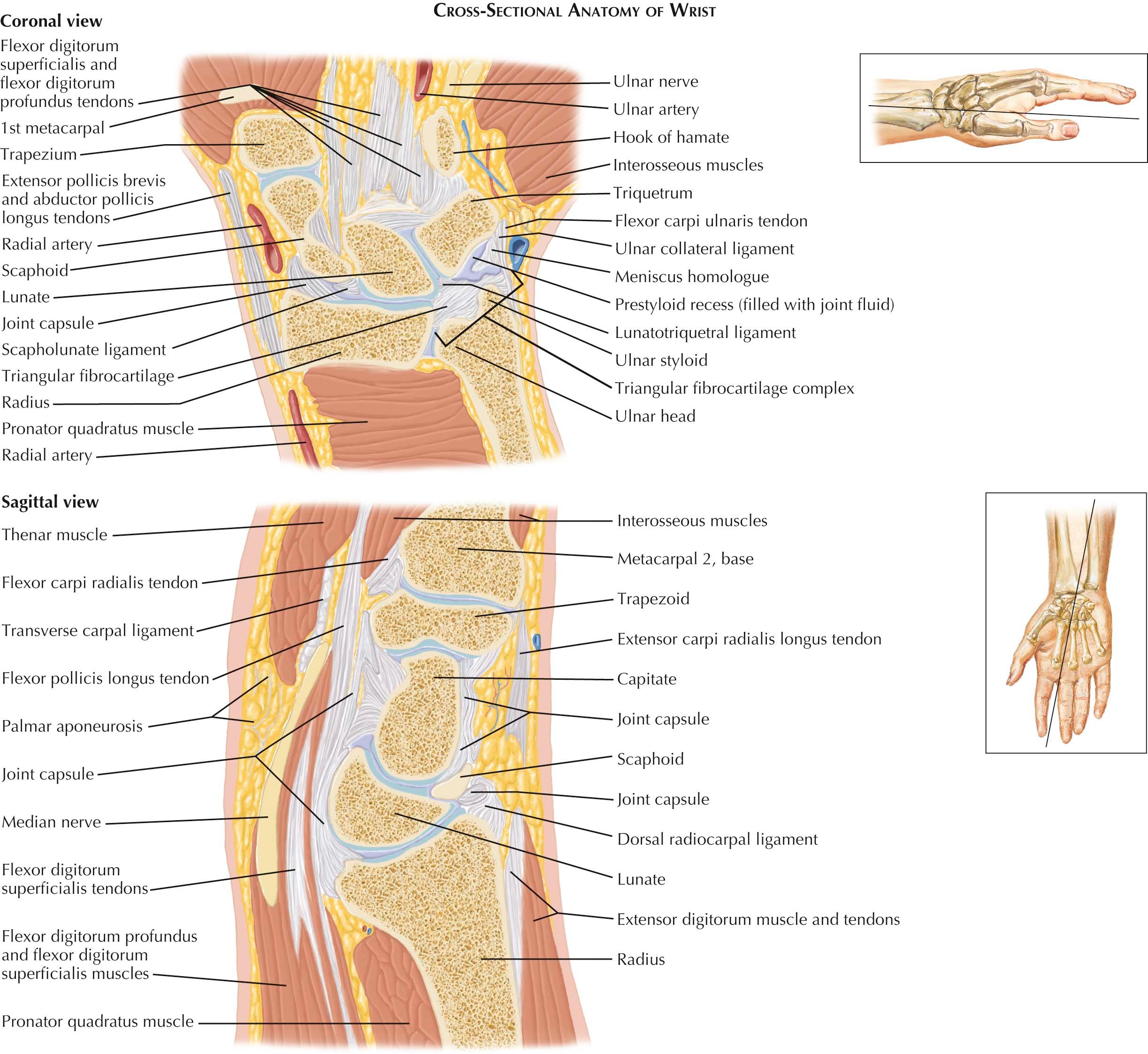
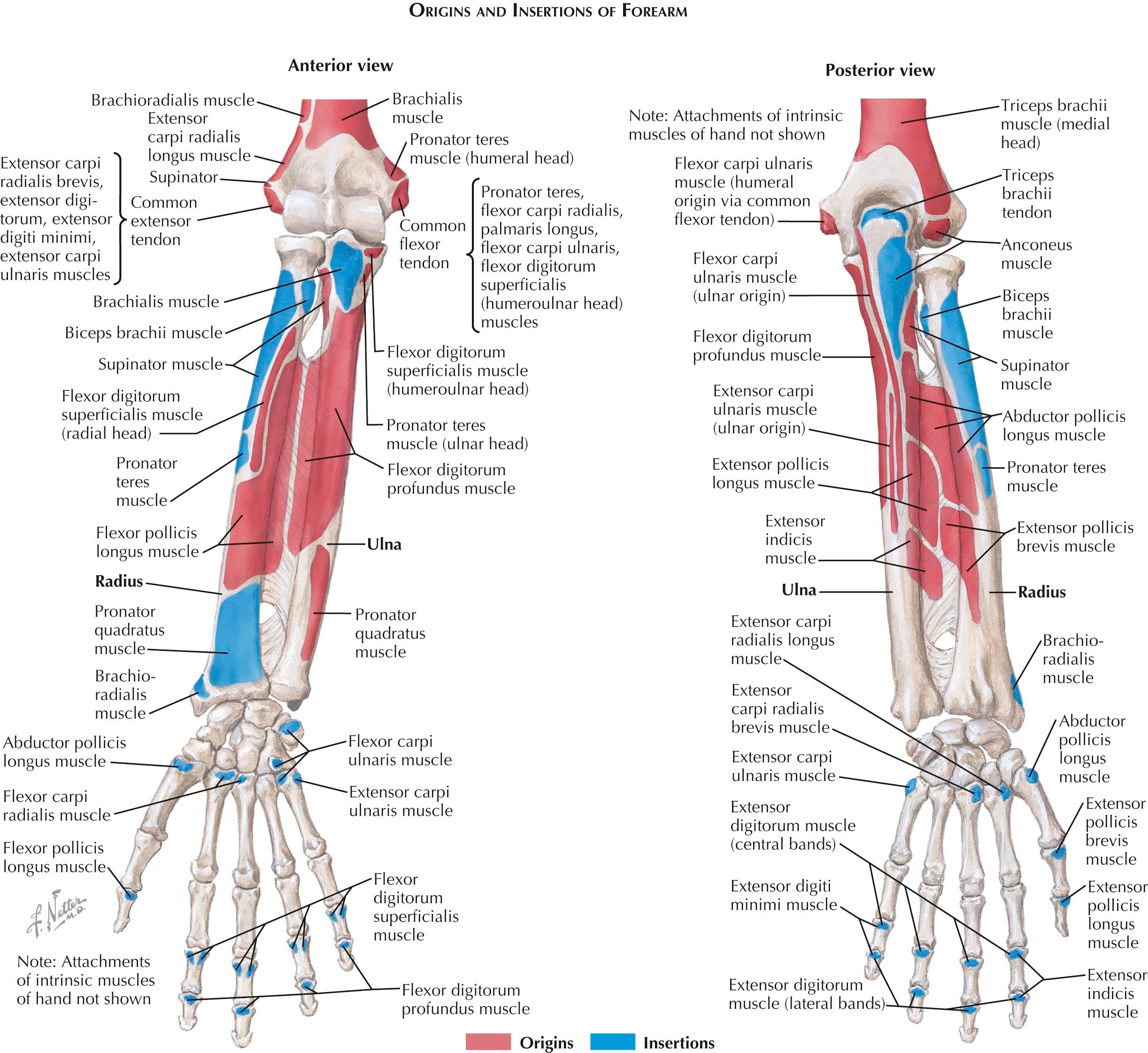
The forearm extends from the elbow to the wrist. It is the territory of two bones—the radius and the ulna—and of many muscles. The muscles are arranged as a flexor mass anteriorly and an extensor mass posteriorly.
There are 19 muscles in the forearm. Eleven are classified as extensor muscles; 8 belong to the flexor group. These designations are simply group characteristics, because certain muscles are primarily rotators of the forearm bones. Eighteen of the muscles can be grouped into six functional groups of 3 muscles each. The muscle excluded from these groups is the brachioradialis, which is actually an elbow flexor with no action in the digits or at the wrist. All the groups, except for the first, are composed of muscles that move the hand and digits.
Rotate the radius on the ulna:
Pronator teres
Pronator quadratus
Supinator
Flex the hand at the wrist:
Flexor carpi radialis
Flexor carpi ulnaris
Palmaris longus
Flex the digits:
Flexor digitorum superficialis
Flexor digitorum profundus
Flexor pollicis longus
Extend the hand at the wrist:
Extensor carpi radialis longus
Extensor carpi radialis brevis
Extensor carpi ulnaris
Extend the digits, except the thumb:
Extensor digitorum
Extensor indicis
Extensor digiti minimi
Extend the thumb:
Abductor pollicis longus
Extensor pollicis brevis
Extensor pollicis longus
The muscles of the first three groups lie in the anterior compartment of the forearm; those of the last three groups are located in the posterior compartment.
The muscles of the second and third groups and the two pronator muscles of the first group comprise the anterior antebrachial muscles. Five of these belong to a superficial layer, and three belong to a deep layer.
The muscles of this layer are listed in the order in which they lie from the radial to the ulnar side of the forearm; the flexor digitorum superficialis, however, is deep to the other four muscles:
Pronator teres
Flexor carpi radialis
Palmaris longus
Flexor carpi ulnaris
Flexor digitorum superficialis
There is a common tendon of origin for these muscles, which is attached to the medial epicondyle of the humerus. The intermuscular septa and the antebrachial fascia also provide partial origins, and certain muscles have additional bony origins.
The pronator teres muscle has both a humeral and an ulnar head. The large humeral head arises in the medial epicondyle via the common tendon and from the adjacent fascia and intermuscular septa. The small, deep ulnar head takes origin from the medial side of the coronoid process of the ulna. It joins the deep aspect of the humeral head, the median nerve descending between them. This obliquely descending muscle ends on the shaft of the radius at the middle of its lateral surface. The insertion is overlaid and obscured by the brachioradialis muscle.
The flexor carpi radialis muscle uses the common tendon of origin. Its tendon accounts for about half of the muscle's length, passes through the wrist in a compartment formed by a split in the flexor retinaculum, and ends in the base of the second metacarpal (frequently, there is an additional slip to the third metacarpal).
The palmaris longus muscle also uses the common tendon of origin, when present (it is absent in 13% of cases). It terminates in a slender, flattened tendon, crossing the wrist superficial to the flexor retinaculum. It constitutes, by its spreading tendinous fibers, the chief part of the palmar aponeurosis.
The flexor carpi ulnaris muscle has a humeral and an ulnar head, the humeral head coming from the common flexor tendon. The ulnar head springs from the medial border of the olecranon and the upper two thirds of the posterior border of the ulna. The tendon of the muscle inserts on the pisiform of the wrist and, through it by two ligaments, into the hamulus of the hamate and the base of the fifth metacarpal.
The flexor digitorum superficialis muscle arises by a humeroulnar and a radial head of origin; these are connected by a fibrous band that crosses the median nerve and the ulnar blood vessels. The larger humeroulnar head arises from the common tendon, the intermuscular septa, the ulnar collateral ligament, and the medial border of the coronoid process. The radial head is a thin layer arising from the upper two thirds of the anterior border of the radius. The muscle forms two planes; the tendons of its superficial plane pass to the middle and ring fingers, and the deep lamina ends in tendons for digits I and V. These tendons terminate in the palmar aspect of the shafts of the middle phalanges of digits II to V (their relationships are described in the discussion of the wrist and hand).
The deep layer contains the following muscles:
Flexor digitorum profundus
Flexor pollicis longus
Pronator quadratus
The flexor digitorum profundus muscle arises from the posterior border of the ulna (with the flexor carpi ulnaris), the proximal two thirds of the medial surface of the ulna, and adjacent areas of the interosseous membrane. The muscle produces, near the wrist, four discrete tendons that pass side by side under the flexor retinaculum and dorsal to the tendons of the flexor digitorum superficialis muscle. The tendons terminate on the bases of the distal phalanges of digits II to V. In the palm, the tendons give origin to the small lumbrical muscles.
The flexor pollicis longus muscle arises principally from the anterior surface of the radius (just below its tuberosity nearly to the upper border of the pronator quadratus) and from the adjacent interosseous membrane. Its tendon, passing between the two sesamoids of the metacarpophalangeal joint of the thumb, inserts on the base of the distal phalanx of the thumb.
The pronator quadratus muscle is a quadrilateral muscle located just above the wrist and deep to the flexor digitorum profundus and flexor pollicis longus tendons. It arises from the anterior surface of the distal one fourth of the ulna, its fibers running transversely across the wrist and inserting into the anterior surface of the distal fourth of the shaft of the radius.
The muscles of the fourth, fifth, and sixth groups, the supinator muscle of the first group, and the brachioradialis muscle make up the posterior antebrachial muscles. Six of these comprise the superficial layer, and five lie in the deep layer.
The six muscles of the superficial layer are listed in the order in which they lie across the back of the forearm, from the radial to the ulnar side:
Brachioradialis
Extensor carpi radialis longus
Extensor carpi radialis brevis
Extensor digitorum
Extensor digiti minimi
Extensor carpi ulnaris
As for the flexor muscles, there is a common tendon of origin from the lateral epicondyle for all muscles arising below the lateral epicondyle.
The brachioradialis muscle arises from the upper two thirds of the supracondylar ridge of the humerus. Its tendon appears at about the middle of the forearm and descends to insert into the lateral side of the base of the styloid process of the radius.
The extensor carpi radialis longus muscle arises from the lower third of the supracondylar ridge of the humerus. It has a flat tendon that reaches into the hand to insert on the dorsum of the second metacarpal.
The extensor carpi radialis brevis muscle uses the common tendon of origin for the extensors. Its tendon appears in the lower third of the forearm, closely applied to the overlying tendon of the extensor carpi radialis longus, and inserts on the dorsum of the base of the third metacarpal.
The extensor digitorum muscle also uses the common tendon of origin for the extensors. Above the wrist, it provides four tendons that spread out on the dorsum of the hand, joined side to side in a variable manner by intertendinous connections. Participating in the rather complex “extensor expansion” described in the section on the wrist and hand, these tendons terminate on the bases of the middle and distal phalanges of digits 2 to 5.
The extensor digiti minimi muscle is a slender muscle that is sometimes only incompletely separated from the extensor digitorum muscle. Its tendon joins the ulnar side of the tendon of the extensor digitorum muscle to the fifth digit for which it provides independent extensor action.
The extensor carpi ulnaris muscle arises by the common tendon from the lateral epicondyle but also from the middle one half of the posterior border of the ulna. It inserts on the ulnar side of the base of the fifth metacarpal.
The muscles of the deep layer are generally submerged under those of the superficial group, although certain of their tendons and parts of their fleshy bellies outcrop just above the wrist:
Supinator
Abductor pollicis longus
Extensor pollicis brevis
Extensor pollicis longus
The supinator muscle has a complex origin from the lateral epicondyle of the humerus, the radial collateral ligament, the annular ligament of the radius, and the supinator crest and fossa of the ulna. Its fibers form a flat sheet, directed downward and lateralward, which wraps almost completely around the radius and inserts on the lateral surface of the upper third of this bone. As the muscle courses into the posterior compartment of the forearm, it is separated into superficial and deep laminae by the deep branch of the radial nerve.
The abductor pollicis longus muscle lies immediately distal to the supinator. It arises from the middle third of the posterior surface of the radius and the lateral part of the posterior surface of the ulna below the anconeus muscle. The fibers of the muscle converge onto its tendon, which, with the tendon of extensor pollicis brevis closely applied to its medial side, crosses the tendons of the extensor carpi radialis longus and brevis muscles and inserts on the radial side of the base of the metacarpal of the thumb.
The extensor pollicis brevis muscle, with origins from the radius and the interosseous membrane distal to that of the abductor pollicis longus muscle, inserts on the base of the proximal phalanx of the thumb. It is a specialization of the distal part of the abductor pollicis longus muscle.
The extensor pollicis longus muscle arises from the ulna and the interosseous membrane distal to the abductor pollicis longus muscle. Its tendon passes to the ulnar side of the dorsal tubercle of the radius, then obliquely across the tendons of both radial carpal extensors, terminating on the base of the distal phalanx of the thumb.
The extensor indicis muscle arises just below the extensor pollicis longus from the ulna and from the interosseous membrane. In the hand, the tendon joins the ulnar side of the tendon of the digital extensor muscle for the index finger and participates with it in forming the extensor expansion over that digit.
Knowledge of the cross-sectional anatomy of the forearm is critical to understanding advanced imaging views of the forearm as well as surgical anatomy. Knowing the origins and insertions of the muscles and tendons of the forearm is helpful during operative dissection and exploration of the forearm and wrist and provides the framework to understanding the functional anatomy of the forearm and wrist.
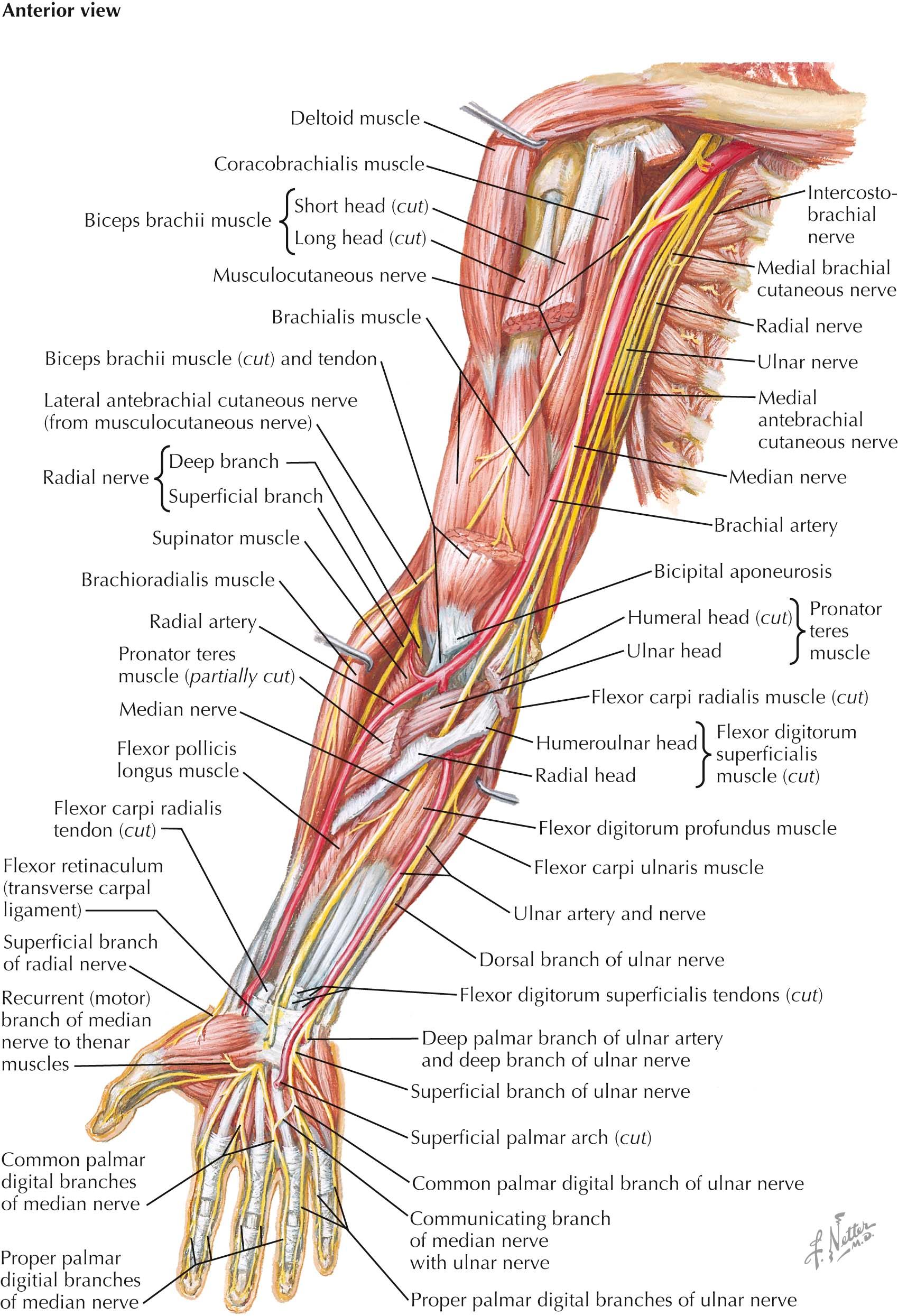
The brachial artery divides into radial and ulnar arteries. Their named branches lie near the elbow and wrist, and only unnamed muscular branches arise in the middle forearm.
This smaller branch continues the direct line of the brachial artery, ending at the wrist at the “pulse position.” It first crosses the tendon of the pronator teres muscle and descends adjacent to the superficial branch of the radial nerve. It branches into the radial recurrent artery and muscular, palmar carpal, and superficial palmar branches.
The radial recurrent artery arises shortly below the origin of the radial artery. Ascending on the supinator muscle, the artery supplies this muscle and the brachioradialis and brachialis muscles and anastomoses with the radial collateral artery (see Plate 3-8 ).
Muscular branches supply the muscles of the radial side of the forearm. The palmar carpal branch arises near the distal border of the pronator quadratus muscle. It ends by anastomosing with the palmar carpal branch of the ulnar artery, the termination of the anterior interosseous artery, and recurrent branches of the deep palmar arterial arch.
The superficial palmar branch leaves the radial artery just before it turns from the radial border of the wrist onto the back of the hand. It descends over or through the muscles of the thumb and joins the superficial branch of the ulnar artery to form the superficial palmar arterial arch.
This larger branch describes a gentle curve to the ulnar side of the forearm. It passes deep to both heads of the pronator teres and all the other superficial flexor muscles of the forearm and is crossed by the median nerve. It lies deep to the flexor carpi ulnaris muscle and enters the hand in company with the ulnar nerve.
The anterior ulnar recurrent artery turns upward from just below the elbow joint between the brachialis and pronator teres muscles. It supplies these muscles and anastomoses with the anterior branches of both ulnar collateral arteries.
The posterior ulnar recurrent artery, larger than the anterior, arises near or in common with it. It ascends between the flexor digitorum superficialis and flexor digitorum profundus muscles to supply the elbow joint. It ends in anastomoses with posterior branches of both ulnar collateral arteries and the interosseous recurrent artery and in the network of the olecranon.
The common interosseous artery arises from the radial side of the ulnar artery and divides into anterior and posterior interosseous arteries. The anterior interosseous artery descends on the anterior surface of the interosseous membrane as far as the upper border of the pronator quadratus muscle in company with veins and the anterior interosseous branch of the median nerve. It gives off nutrient arteries to the radius and ulna and a long slender median artery to the palm. At the upper border of the pronator quadratus muscle, a small palmar carpal branch is given off. The artery terminates in the dorsal carpal network.
The posterior interosseous artery passes to the back of the upper forearm, emerging between the supinator and abductor pollicis longus muscles with the deep branch of the radial nerve. Sending twigs to the extensor muscles of the forearm, it descends to anastomose with the dorsal terminal branch of the anterior interosseous artery. An interosseous recurrent branch ascends deep to the supinator and anconeus muscles to the interval between the lateral epicondyle of the humerus and the olecranon; there, it communicates with the middle collateral, inferior ulnar collateral, and posterior ulnar recurrent arteries.
Muscular branches of the ulnar artery reach the muscles of the ulnar side of the forearm. The palmar carpal branch arises at the upper border of the flexor retinaculum, passes across the wrist deep to the flexor tendons, and unites with the palmar carpal branch of the radial artery. The dorsal carpal branch arises just above the pisiform. It winds around the border of the wrist, deep to the tendons, to help form the dorsal carpal arterial arch.
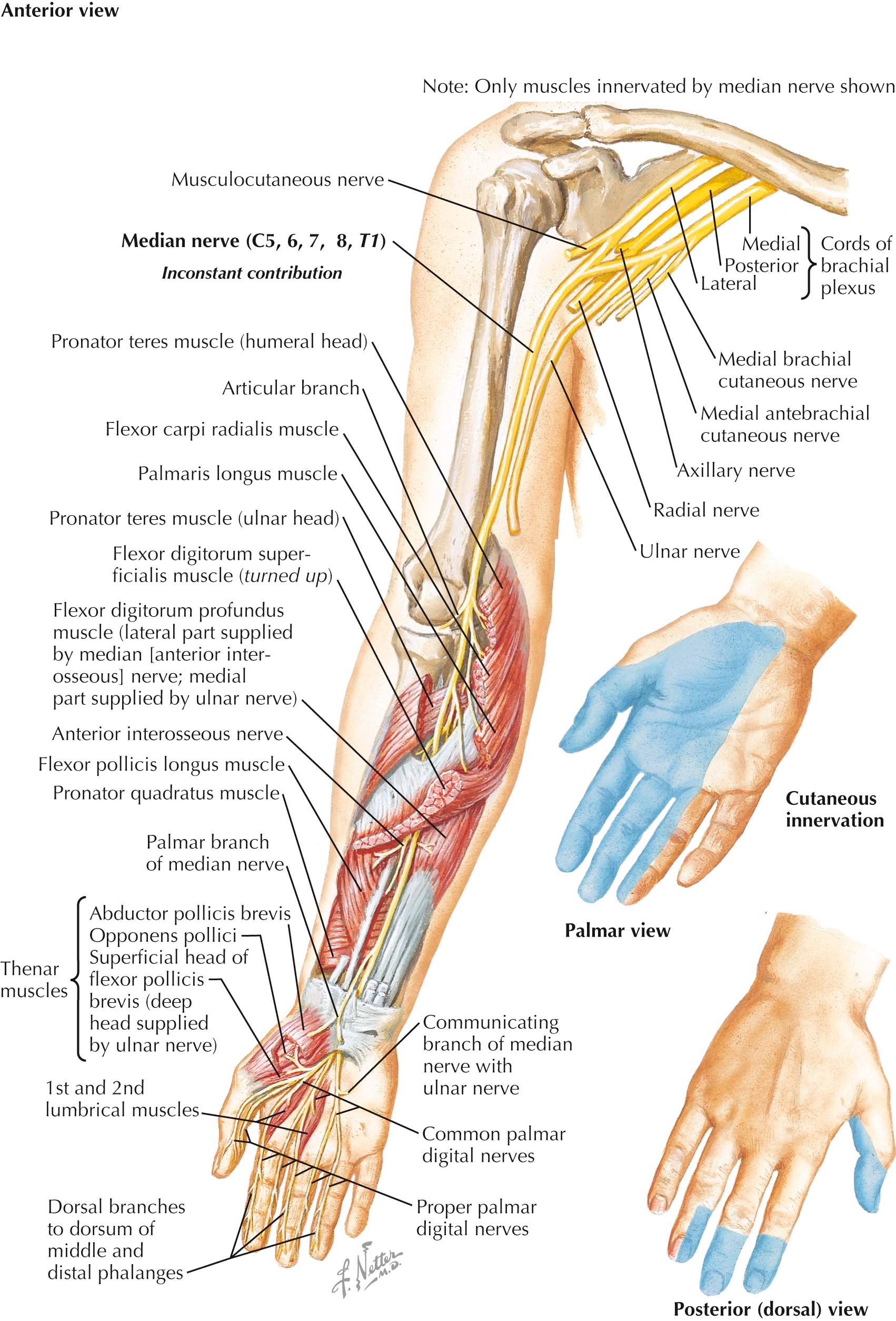
The median nerve (C[5], 6, 7, 8; T1) is formed by the union of medial and lateral roots arising from the corresponding cords of the brachial plexus (see Plate 3-14 ).
The median nerve runs from the axilla into the arm, lateral to the brachial artery. At about the level of the insertion of the coracobrachialis muscle, the nerve inclines medially over the brachial artery and then descends along its medial side to the cubital fossa. Here, it lies behind the bicipital aponeurosis and the median cubital vein and in front of the insertion of the brachialis muscle and the elbow joint. (The close proximity of the vein, artery, and nerve should be remembered when performing venipuncture in this area.) The only branches given off in the arm are filaments to the brachial vessels and an inconstant twig to the pronator teres muscle.
The nerve passes into the forearm between the humeral and ulnar heads of the pronator teres muscle, the latter separating it from the ulnar artery. It then runs deep to the aponeurotic arch between the humeroulnar and radial heads of the flexor digitorum superficialis muscle and continues downward between this muscle and the flexor digitorum profundus muscle. In the forearm, the nerve supplies branches to the pronator teres, flexor digitorum superficialis, flexor carpi radialis, and palmaris longus muscles and articular twigs to the elbow and proximal radioulnar joints.
The longest branch is the anterior interosseous nerve, which, accompanied by the corresponding artery, runs downward on the interosseous membrane between the flexor pollicis longus and the flexor digitorum profundus muscles; it supplies the former muscle and the lateral part of the latter and ends under the pronator quadratus, supplying this muscle and the distal radioulnar, radiocarpal, and carpal joints. Vascular filaments help to innervate the ulnar and anterior interosseous vessels and the nutrient vessels of the radius and ulna. A palmar branch arises 3 to 4 cm above the flexor retinaculum and descends over it to supply the skin of the median part of the palm and the thenar eminence. In the forearm, the median and ulnar nerves are occasionally interconnected by strands, which may explain certain anomalies in the nerve supply of the hand.
In the lower forearm, the median nerve becomes more superficial between the tendons of the palmaris longus and the flexor carpi radialis muscles. Together with the tendons of the digital flexor muscles, it enters the palm through the carpal tunnel that is bound anteriorly by the tough flexor retinaculum and posteriorly by the carpal bones. Emerging from the tunnel, the nerve splays out into its terminal muscular and palmar digital branches. The muscular branch arises close to, or is initially united with, the common palmar digital nerve to the thumb; it curves outward over or through the flexor pollicis brevis muscle to supply it before dividing to supply the abductor pollicis brevis and opponens pollicis muscles. The muscular branch may also supply all or part of the first dorsal interosseous muscle. In rare instances, it arises in the carpal tunnel and pierces the flexor retinaculum—an arrangement of potential clinical concern.
The common and proper palmar digital nerves vary in their origins and distributions, but the usual arrangement is that shown in Plates 3-13 and 3-14 . The proper palmar digital nerves give off dorsal twigs, which innervate the skin (including the nail beds) over the distal and dorsal aspects of the lateral three and one-half digits. Occasionally, they supply only two and one-half digits. The proper palmar digital branches to the radial side of the index finger and to the contiguous sides of the index and middle fingers also carry motor fibers to supply the first and second lumbrical muscles, respectively. Therefore, the digital nerves are not concerned solely with cutaneous sensibility. They contain an admixture of efferent and afferent somatic and autonomic fibers, which transmit impulses to and from sensory endings, vessels, sweat glands, and arrectores pilorum muscles and between fascial, tendinous, osseous, and articular structures in their areas of distribution.
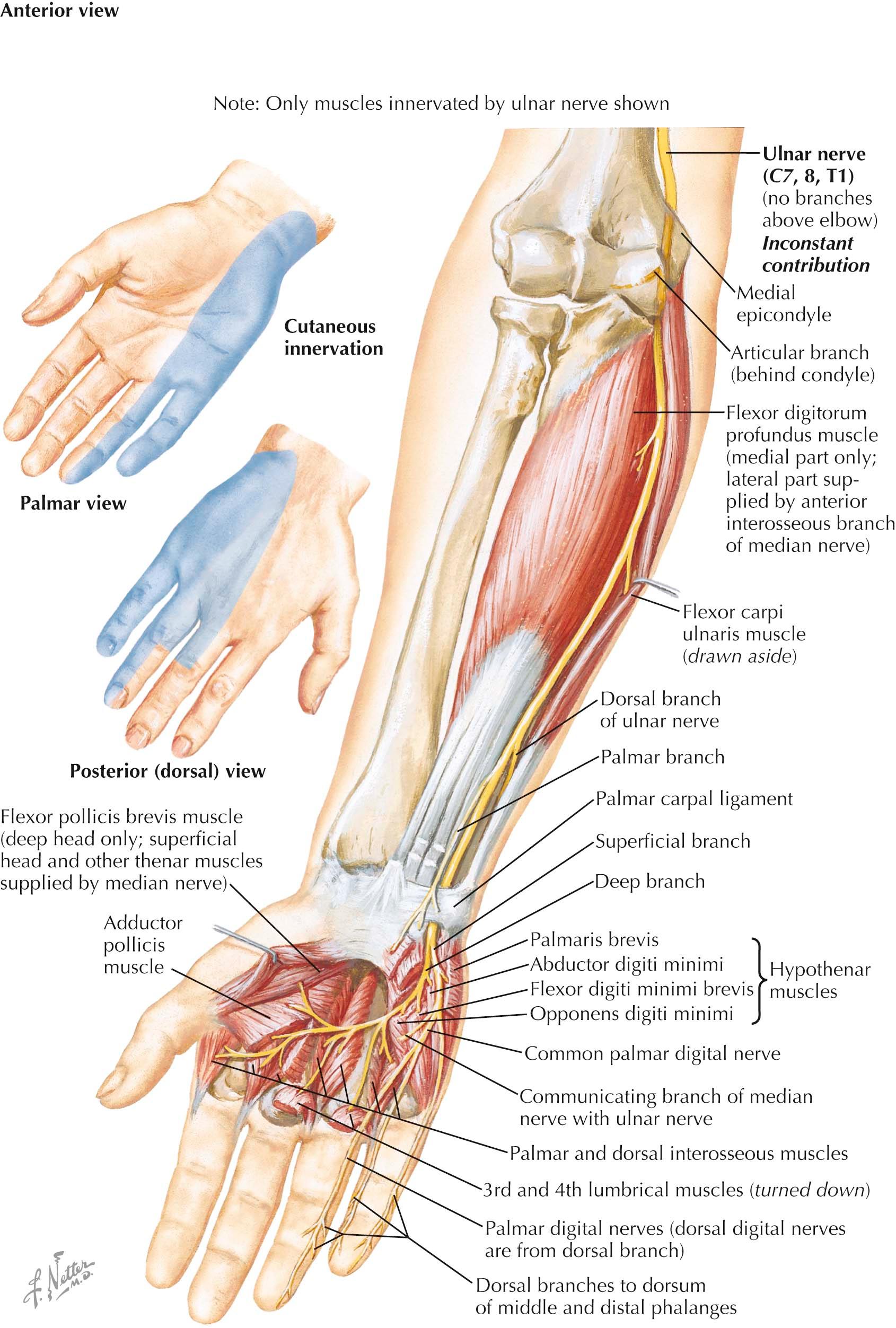
The ulnar nerve (C[7], 8; T1) is the main continuation of the medial cord of the brachial plexus (see Plate 3-13 ).
Initially, the ulnar nerve lies between the axillary artery and vein; as it enters the arm, it runs on the medial side of the brachial artery. At about the middle of the arm, it pierces the medial intermuscular septum and descends anterior to the medial head of the triceps brachii muscle, alongside the superior ulnar collateral artery. In the lower third of the arm, it inclines posteriorly to reach the interval between the medial humeral epicondyle and the olecranon. As the nerve enters the forearm, it lies in the groove behind the medial epicondyle, between the humeral and ulnar heads of the flexor carpi ulnaris muscle. Above the elbow, the ulnar nerve supplies no constant branches.
The ulnar nerve runs downward on the medial side of the forearm, lying first on the ulnar collateral ligament of the elbow joint and then on the flexor digitorum profundus muscle, deep to the flexor carpi ulnaris muscle. At the elbow, the ulnar nerve and artery are separated by a considerable gap, but they are closely apposed in the lower two thirds of the forearm, with the artery on the lateral side. At the flexor carpi ulnaris tendon, the nerve and artery emerge from under its lateral edge and are covered only by skin and fascia. They reach the hand by crossing the anterior surface of the flexor retinaculum lateral to the pisiform, and the nerve splits, under cover of the palmaris brevis muscle, into its superficial and deep terminal branches.
Become a Clinical Tree membership for Full access and enjoy Unlimited articles
If you are a member. Log in here